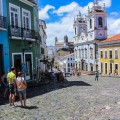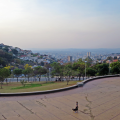Meetings with Remarkable Brazilians
When I was planning my trip to Salvador I told Avanti Destinations, my destination manager, that I was interested in constructing a sort of cultural tour. I didn’t want to do excursions out of town. Salvador itself would be more than enough for the time I had. I wanted time to explore on my own, relax, reflect and process. I didn’t want to be running around trying to see everything possible on the standard must-see list.
What I wanted was an easygoing experience of cultural immersion. The city tours were a good introduction and orientation to the city and were helpful in creating the foundation for the rest of the trip. I also booked a handful of other activities selected from a broad range of possibilities Avanti makes available.
A major drum ensemble in Pelourinho
One of the meetings Avanti arranged for me was a percussion workshop, a lesson in Brazilian rhythms with Giba Conçeicão, one of the top percussionists of Brazil.
Giba Conçeicão has played and recorded with Brazilian music stars such as Gilberto Gil and Paulinho da Viola. A year after starting his musical career he was named Best New Musician in the Troféu Caymmi, a prestigious showcase of Bahian music.
In 2000 he appeared as an actor and percussionist in the movie “Woman on Top” starring Penelope Cruz. He is involved in UNICEF projects and has traveled extensively teaching percussion to children throughout Brazil and in Africa.
For me just to be in the same room as this man would have been an honor. Through Avanti I was able to meet him personally in his studio, visit with him and receive a rudimentary lesson in Brazilian rhythms. It was a great privilege, a rare window into local culture.
Giba taught me the basic samba beat and showed me how to play it on two percussion instruments, a tambourine and an agogo, an instrument with two bells played with a stick.
He was patient and kind in his instruction and helped me to more or less master a couple of simple rhythms, which I recorded for future reference. My guide Alfredo was there to help bridge the language gaps.
His studio was like a tiny museum packed with percussion instruments he had gathered from his travels around the world. He had collected a great variety of such instruments as the reco reco, played by scraping a stick over a grooved surface of wood or metal; the cuica, which looks like a drum but is played by pulling a strap and creating friction that makes a squeaking sound heard often on Brazilian recordings; a berimbao, made with a bow with a single string; a chucahlho, a shaker; and a caxixi, a basket filled with seeds that rattle against a drum head.
He had many varieties of these kinds of instruments in his studio. He showed delight at having found ancient indigenous instruments that were essentially the same in Africa as in South America, showing some kind of ancient pre-historical unity among world cultures.
The most remarkable thing about meeting Giba cannot be described in terms of his musical credentials, or his specific actions while I was there, but just that he was a warm and radiating personality. He embodied a kind of grace and spiritual harmony as if he himself was an expression of music.
He was gracious and kind and a great pleasure to be in the presence of. That is the ultimate take-away of the meeting, and there are no words to describe it.
The workshop was originally supposed to be an hour, but Giba was generous with his time and kept entertaining us for hours. It was one of those extremely valuable moments that you take away with you and keep forever. I am grateful to Avanti for arranging it because there was no way I was going to be able to arrange anything like that on my own.
Another of the meetings arranged by Avanti was a chance to observe a Capoeira lesson taught by Metre Valmir, of the International Foundation of Capoeira. At age 49 going on 50, Mr. Valmir has been a devotee of Capoeira for 34 years. His physical condition, as he demonstrated the moves of Capoeira, was mind boggling. He was able to move his body in flying and floating gymnastic motions that would seem impossible without some kind of cord attached.
With Alfredo as translator Mr. Valmir explained much about Capoeira, where it came from and how it developed.
Capoeira dates from the 16th century. As with so many things in the modern world Capoeira has its origins in the great crime of slavery. West Africans who were captured and forced to do labor in Brazil developed Capoeira as a kind of martial art that was also a style of dance. It was based on music and lore originally from West Africa but it was developed in Brazil.
The fact that the martial art could be disguised as dance made it possible for enslaved Africans to practice it discreetly without alerting the slave masters to the fact that they were building their strength and their ability to do battle.
Also on my schedule of activities was “Bahia by Night.” It included dinner and a dance performance at Teatro Miguel Santana in Pelourinho, the historic district. The dance performance was an amazing demonstration of physical prowess by dancers who could flip and fly through the air and seemed to be able to do practically anything they imagined with their bodies.
Dressed in elaborate, colorful costumes the dancers portrayed gods and goddesses from Candomblé, a religion developed in Brazil based on African animistic religions.
Brazilian colorful costumes from Candomblé
That night we had dinner at Maria Mata Mouro restaurant in the historic district. Alfredo introduced me to a Brazilian specialty called moqueca. Based on African cuisine, moqueca is a fish stew with coconut milk, tomatoes, onions, garlic, coriander and palm oil.
It was all good for the body, mind and soul. It gave me a little piece of Brazil to take home with me and cherish forever.
To read more of David’s experiences in Brazil, please visit: http://www.travelpulse.com/bio/david-cogswell


 Conectando sua conta
Conectando sua conta 








 no
no



